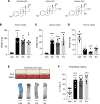The different natural estrogens promote endothelial healing through distinct cell targets
- PMID: 36729672
- PMCID: PMC10070101
- DOI: 10.1172/jci.insight.161284
The different natural estrogens promote endothelial healing through distinct cell targets
Abstract
The main estrogen, 17β-estradiol (E2), exerts several beneficial vascular actions through estrogen receptor α (ERα) in endothelial cells. However, the impact of other natural estrogens such as estriol (E3) and estetrol (E4) on arteries remains poorly described. In the present study, we report the effects of E3 and E4 on endothelial healing after carotid artery injuries in vivo. After endovascular injury, which preserves smooth muscle cells (SMCs), E2, E3, and E4 equally stimulated reendothelialization. By contrast, only E2 and E3 accelerated endothelial healing after perivascular injury that destroys both endothelial cells and SMCs, suggesting an important role of this latter cell type in E4's action, which was confirmed using Cre/lox mice inactivating ERα in SMCs. In addition, E4 mediated its effects independently of ERα membrane-initiated signaling, in contrast with E2. Consistently, RNA sequencing analysis revealed that transcriptomic and cellular signatures in response to E4 profoundly differed from those of E2. Thus, whereas acceleration of endothelial healing by estrogens had been viewed as entirely dependent on endothelial ERα, these results highlight the very specific pharmacological profile of the natural estrogen E4, revealing the importance of dialogue between SMCs and endothelial cells in its arterial protection.
Keywords: Cardiovascular disease; Endocrinology; Endothelial cells; Sex hormones; Vascular Biology.
Conflict of interest statement
Figures







References
Publication types
MeSH terms
Substances
LinkOut - more resources
Full Text Sources
Molecular Biology Databases

